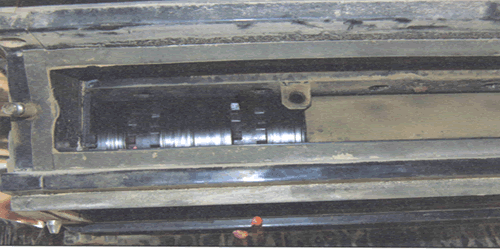
Lambton Farmer Not Ready To Give Up On Air Seeding Corn
| With hundreds of acres to manage, there is no time to waste for Harry Buurma and his sons. This is especially true during the spring planting time, when there are several different crops to be planted and a limited time to do so. With heavy clay soils, the weather can really throw a monkey wrench into the picture. The seeding window is short so any good planting days are taken advantage of and if there are measures that can be taken to get the job done quicker and more efficiently, they are considered. That is the main reason the Buurma's decision to try and get his 40' air-seeder to plant corn - get the job done faster. |
|
Harry Buurma farms, together
with his sons, on soils with high clay content near Glencoe in Middlesex and
Lambton Counties. Together they have close to 2800 acres which are planted to
a variety of crops including grain corn, soybeans, canola, and wheat. In 2005
they grew about 500 acres of corn. This is not the first year that the Buurma's
have used an air-seeder to plant corn, but this year it seemed that more of
the bugs had been worked out of the system. For instance, the GP5 guidance system
which provides auto-steer for the tractor, as well as the monitor that provides
seeding and fertilizer rates both appeared to be working as they should. In
previous years, they had problems getting these systems to function properly.
Also, after a discouraging first year, a couple of years ago, they felt they
had been given more ammunition for trying this system out again. Recent research
suggests that plant spacing variability does not affect yields as much as commonly
thought. Findings such as this make the Buurma's willing to try out their air-seeder
again, even though an airseeder typically produces greater stand variability.
So where does the planting
speed come from? The air-seeder that the Buurma's are using, which is a Case
IH, has a split compartment which holds 84 bushels of corn seed and about 8,000
lbs of fertilizer. This enables planting with very few stops to fill the planter
up. The second reason for speed is the unit width; which plants 24 rows on 20
inch centers (40 feet in total). To get that sort of capacity they would need
a 16 row corn planter. The air- seeder uses single disc drill openers. The rear
gang of openers locks up for planting corn in 20" rows or in the engaged
position, plants crops in 10" rows.
The air-seeder's tank in
this arrangement is towed between the tractor and the actual planter unit. The
seed is metered via a roller bar and does not singulate seeds like a typical
corn planter, but total plant population has been fairly reliable.
Buurma and his sons use their airseeder to plant wheat, soybeans, canola, and corn. This year when they planted corn, one of the hoppers held the starter fertilizer, and the airflow was set to deliver about 8 lbs of nitrogen per acre with the seed. The remainder of the nitrogen was top-dressed using 28% (VAN) through the sprayer, shortly after planting. The air-seeder comes with a monitor, which is mounted in the tractor cab. The monitor gives the seeding rate per acre and warns if one of the hoses gets plugged.
 Figure 2. Metering rol/s seem to give good population control but seed spacing is certainly not "picket fence". |
|
The Buurma's, hoping to reaffirm their decision to try their airseeder out again, planted some test strips this year comparing their airseeder with a typical row-unit planter using a singulated metering system. To obtain a side-by-side comparison of the two planters, several areas in the field were hand-harvested, and overall, the air-seeder actually generated yields equal to or greater than the conventional planter. Buurma believes that the 20" row spacing tends to smooth out some of the impacts from uneven spacing within the row. After all is said and done, Harry states that he is certainly not discouraged with the 2005 results of the air-seeder and more than likely will keep trying to use and improve the system.